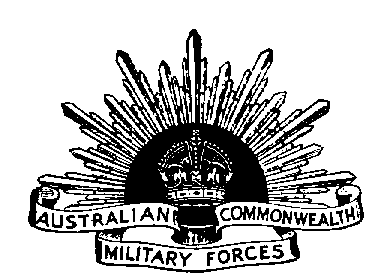

I have tried to avoid using any military abbreviations whatsoever as these can be obscure. The reader should be aware that many units were only ever be referred to by their abbreviations.
Colour patches where worn, are depicted. These were patches of cloth worn on both sleeves. Their use was introduced on 8 March 1915. Colour patches are not shown to scale. In some cases, the colour patch of the unit changed during the war. The final one is always the one shown. Occasionally, an unofficial shoulder patch was worn. This is so noted where it occurred.
Foreign units (British, French, New Zealand, etc) are listed in italics where they were part of (not merely attached to or administered by) an Australian formation. All are preceded by their nationality. Likewise, foreign commanders are listed in italics. Australian units generally do not have the word "Australian" in their title although often it was frequently used at the time in order to distinguish them from foreign units. Many Australian units also had British titles and these are noted. I haven't been pedantic about what was and was not an Australian formation.
Units raised twice are so noted by a (1) or (2).
Parent units or formations, where a unit was part of such a unit or formation, this is indicated in square brackets. Only the final parent formation is so noted but the others, if any, are noted in the text.
State affiliations of units are listed, where known, in round brackets after the unit designation. It should be noted that there are two types of affiliations: where the units were formed and from whence they drew their reinforcements. This referred to the individual's state of enlistment rather than state of origin, and that the term "state" as used by the army and in this Order of Battle actually refers to the military districts which differ slightly from the state boundaries. In particular, the 3rd Military District (Victoria) and the 4th (South Australia) included parts of New South Wales.
Specialist weapons units such as artillery batteries have their primary weapons listed after them in square brackets.
Theatre where the unit fought is noted below in italics. In the case of higher formations, I have included a more detailed description of where the unit fought. See About the Battles and Campaigns of the AIF for more details.
Battle Honours were awarded to some units after the war. Where this is the case, they are so noted. See About the Battles and Campaigns of the AIF for more details.
The Text, where possible, the text includes the date of formation, the date of embarkation, the ships on which the unit embarked and the date on which the unit was disbanded.
Each Division is listed several times in the Formations part in order to chart organisational changes. Dates have been chosen to coincide with major reorganisations. A Division narrative has been supplied, together with some other details about the organisation.
Sources are listed in the bibliography.
Main 1st Division 2nd Division 3rd Division 4th Division 5th Division 6th Division NZ & Australian Division Anzac Mounted Division Australian Mounted Division
Page created by Ross
Mallett
ross@metva.com.au